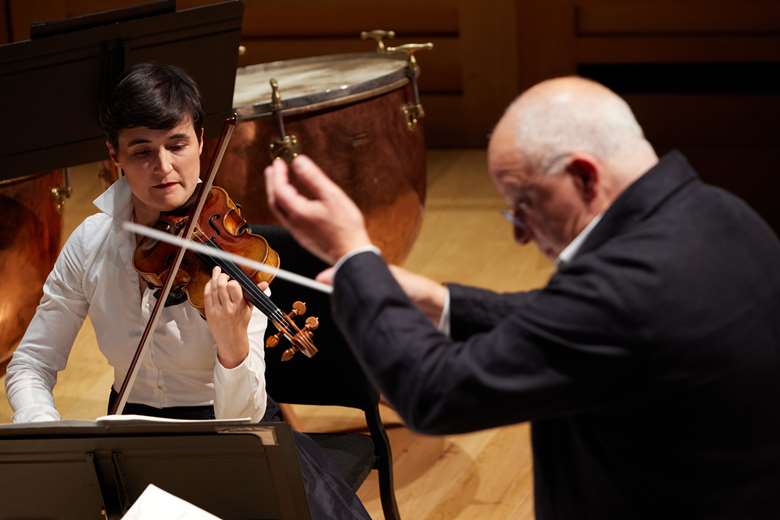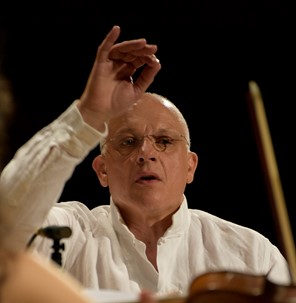Peter Manning: ‘The orchestra as we know it’
Peter Manning
Thursday, May 5, 2022
The artistic director and principal conductor of the Bath Festival Orchestra talks about the origins and future of the orchestra, explaining how technological innovation can help us evolve beyond the sound-world of the mid-19th century

In 1610, the composer Claudio Monteverdi travelled to Rome to meet Pope Paul V, whilst working for the Gonzagas, the Dukes of Mantua. During his visit, he handed the Pope a personal dedication (dated 1 September) of his newest work, The Sanctissimae Virgini Missa Sensis Vocibus, known as the Monteverdi Vespers of 1610.
Monteverdi not only delivered a score that showed the perfect balance between music and text, but most importantly, he was the first composer to name the instruments required to perform each part written in the full score. The majority of art-music works written for orchestral groups prior to this point tended not to have designated instruments or instrumental groups playing each individual part. Instead, it was up to the musicians to match each part to an available instrument.
This all changed in 1610. After this, fuller emphasis was placed on which instrument played which part according to the composers’ requirements, with greater consideration given to texture, volume, line, harmony, rhythm and the compositional process. This progression lent itself to newer, formalised, instrumental grouping within the orchestra, which in turn led to the fabrication and invention of new orchestral instruments in the strings, brass, woodwind and percussion family. As a result of this pioneering work, the orchestra as we know it today - with its lesser or greater numbers - became more fully organised and even more visible beyond the court classical period orchestras throughout Europe in the 18th century.
Further technical advances in instrument fabrication of the 1820s allowed many composers, most notably Berlioz and Wagner, to make use of this increase in available sounds and create a more expressive and pure abstract sound world, moving into the 20th century with ever braver orchestral opportunities. Since then, we have been on an uninterrupted journey to create newer sounds, structures and aural imaginings. The orchestral sound of today continues to develop alongside the upgrading of computer aural logic systems and the ever-increasing availability of choice with respect to the world of sound and orchestral instruments.
 So how does all of this background impact upon the ‘orchestra as we know it’? This was indeed a question that I was faced with as Bath Festival orchestra’s (BFO) artistic director when enabling discussions with our newer generation of professional orchestral performers and artists. These conversations have led to new strands of thinking about our future performance as well as our creative and practical lives as orchestral artists. As our discussions develop it has become clear that the orchestra as we have come to know it, with its usual mix of instruments, is essentially the orchestra and technical orchestral sound-world of the mid-19th century.
So how does all of this background impact upon the ‘orchestra as we know it’? This was indeed a question that I was faced with as Bath Festival orchestra’s (BFO) artistic director when enabling discussions with our newer generation of professional orchestral performers and artists. These conversations have led to new strands of thinking about our future performance as well as our creative and practical lives as orchestral artists. As our discussions develop it has become clear that the orchestra as we have come to know it, with its usual mix of instruments, is essentially the orchestra and technical orchestral sound-world of the mid-19th century.
When re-launching the BFO, which has been rebuilt and relaunched over the last 3 years (and been a personal brainchild of mine over the last two decades), we discussed a newer vision in which the double wind and string orchestra (known as the Chamber orchestra) would be the essential background grouping of choice. As the ideal instrumental structure for flexibility, it would be the central provider of sounds and expressions upon which instruments and voices could be freely added to, both for existing and newer compositions.
The changes required to transform the ‘orchestra as we know it’ into a more relevant format for today’s world can embrace all forms of music communication and performance. For us at the BFO this begins with an education focus with long term creative values.
The orchestra very early on established the Orchestrate programme which seeks to bring younger people into the world of music and its possibilities. It was essential that we established newer platforms at the school level to offer performance opportunities and generate interest at a critical time for young people and we have also set up a twinned programme between the Bobby Moore Academy in East London and St Mary Le Strand Church in central London, teaching aspiring young musicians and performing alongside them.
Much as Wagner re-evaluated Beethoven, who re-evaluated Mozart, who re-evaluated Handel, we too are re-evaluating. This is a natural process of intergenerational musical communication, exploration and opportunity which allows the orchestra today to flourish as an active and evolving art form.
Thinking ahead, as a new generation of concert halls and public spaces evolve alongside the older concert spaces, there is the younger generation of professional musicians who are ready to engage with the wider community through an increase in orchestral public events, broad repertoire and innovative programming alongside the ever more elegant technical developments of our age.
It seems a long time since this orchestral innovation, activity and energy was launched but orchestral development has always curiously responded in parallel to creative partnerships with all forms of technical, scientific, human and inspirational development. It’s a great privilege and exciting for all of us at the BFO to see where the next developments may form and progress this magnificent more-than- four-hundred-year art form.
The Bath Festival Orchestra will take to the Roman Baths on 16 May 2022 as part of the Bath Festival to present a programme of music inspired by the sea. You can find out more here.
